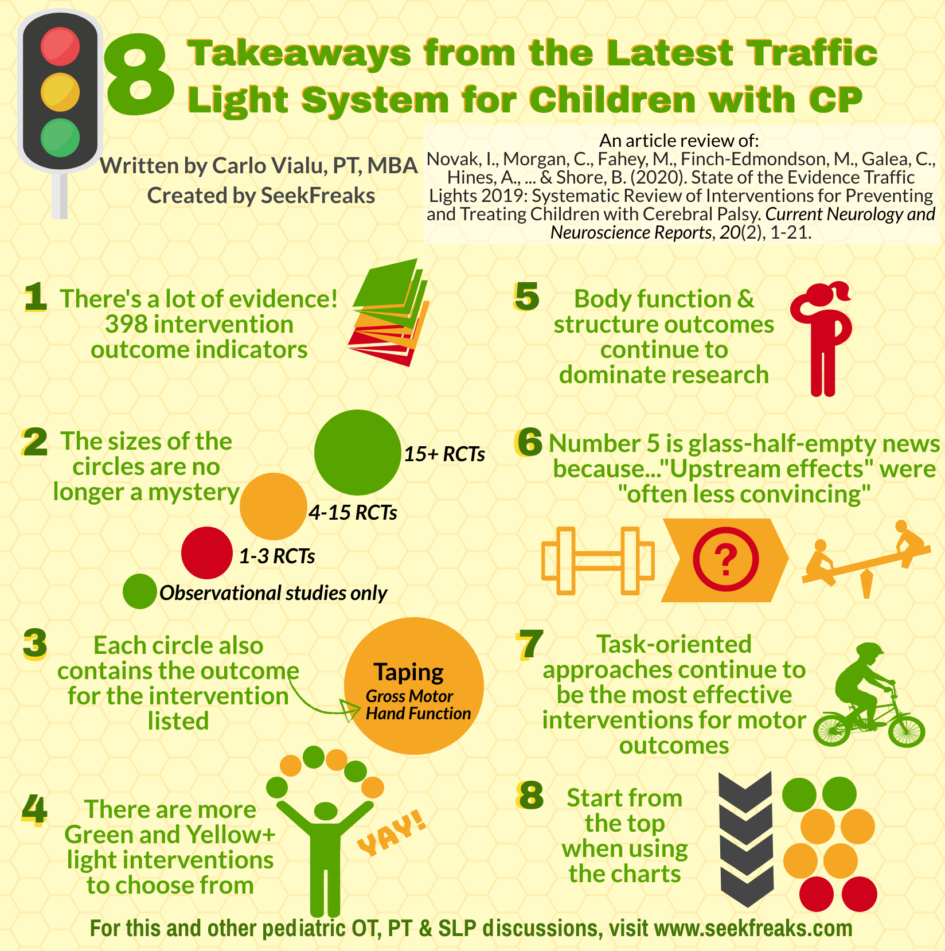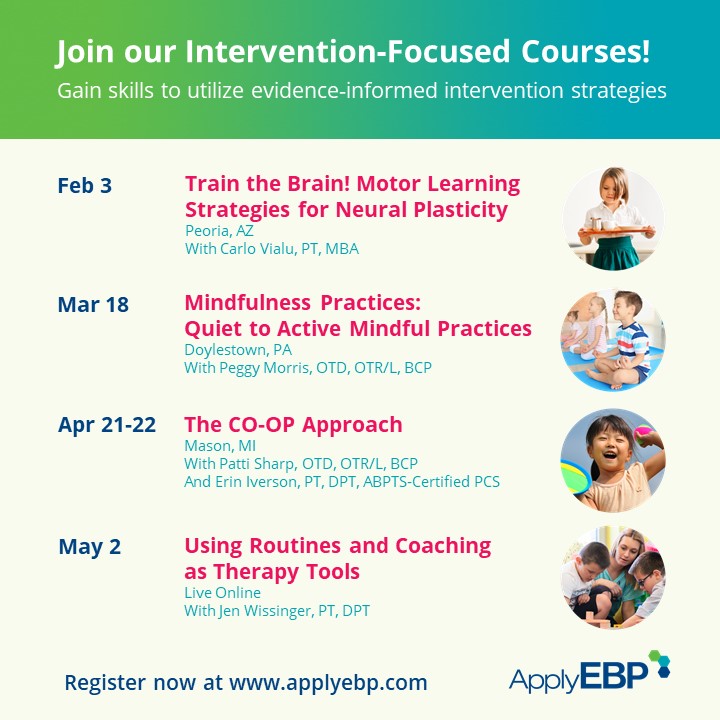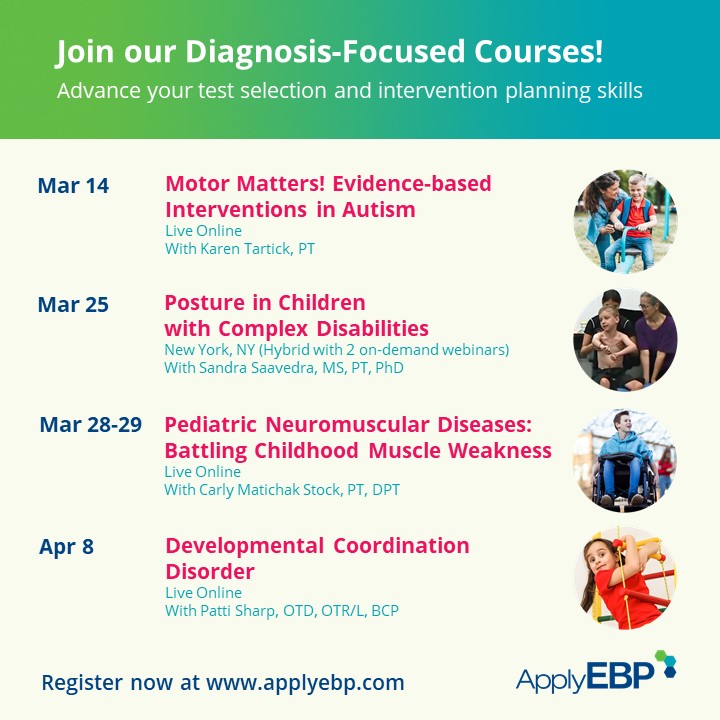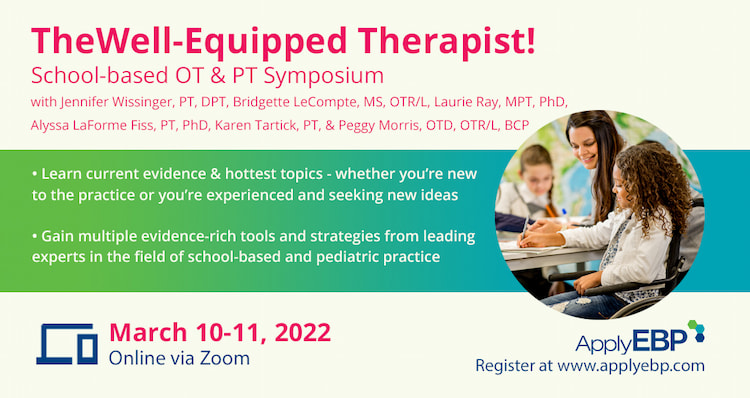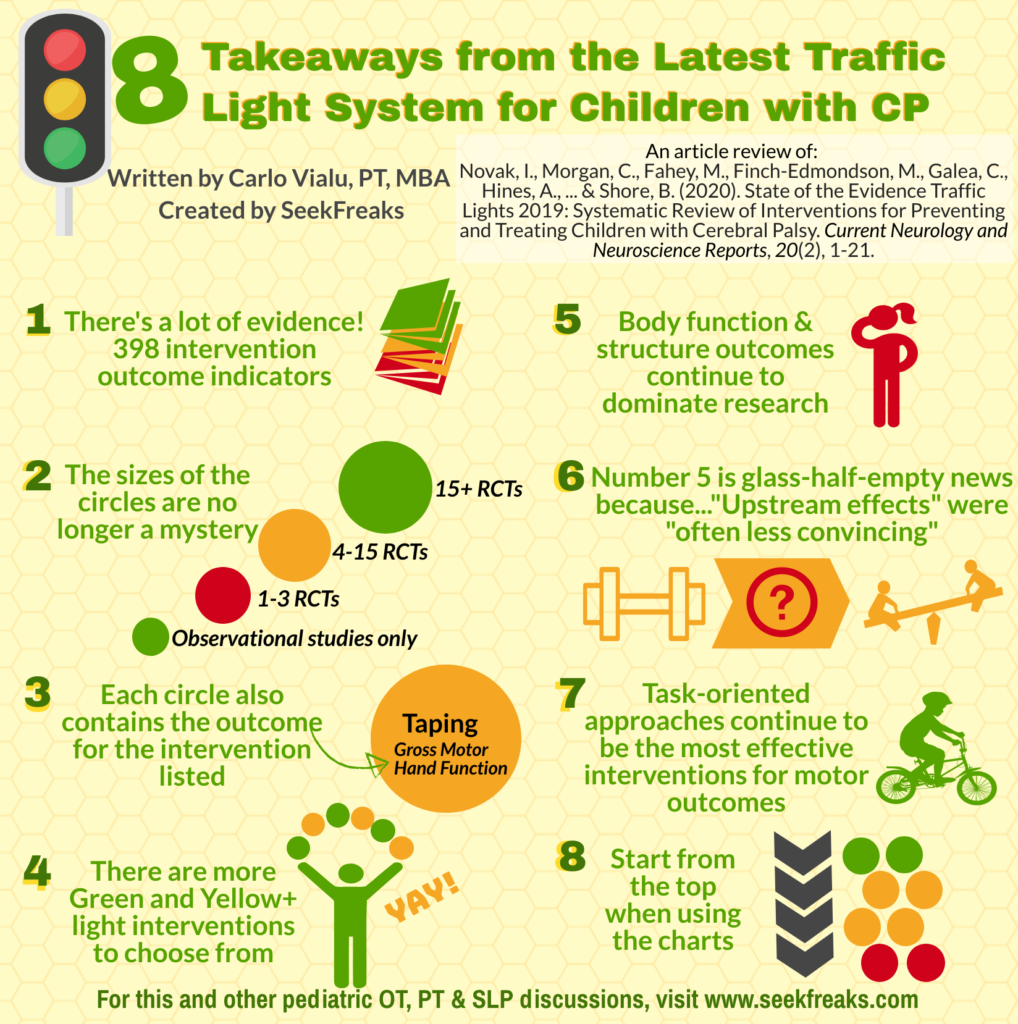
The author, Carlo Vialu, PT, MBA, is co-creator of SeekFreaks. He loves promoting function and participation for children and youth with disabilities, from our assessment to our interventions, via his continuing education courses: The Well-Equipped Therapist! School-based OT & PT Hybrid Symposiums x3. More about these courses after the article.
Boy, was I excited when my co-Apply EBP mentor, Jennifer Wissinger, notified me of the publication of the newest Traffic Light of interventions for children with cerebral palsy by Novak et al, 2020! Yes, this is an update of the 2013 study by Novak, et al.
What can happen in 7 years? The answer is…A LOT of research!
Here are SeekFreaks Takeaways from this study:
1. There’s a lot of evidence! 398 intervention outcome indicators
Just in case you are wondering, that’s triple compared to the 2013 study, when there were only 131 intervention outcome indicators!
So, if you’re like me…tired of hearing “there’s very few evidence in our practice”, let us hold hands, breathe in together, and put that to rest. Perhaps what practitioners really mean is “I do not have enough time to search for evidence.” This is not a judgment, but just stating the obvious.
But now, we have this paper that summarizes them all…no more excuses! Thank you to the authors who did the searching, appraising and write-up. It is now up to us to digest them and apply them to our practice.
Having a lot of evidence does not mean we stop here. If the evidence triples in 7 years, how much more will be there in another 7! Let’s support our researchers to further enrich our practice.
2. The sizes of the circles are no longer a mystery
The Traffic Light system of Green (Do it), Yellow + (Probably do it), Yellow – (Probably don’t do it), and Red (Stop! Don’t do it) from the 2013 study was truly helpful for clinicians. I also suggest reading Peggy Morris, OTD, OTR/L, BCP’s discussion of the use of the Traffic Light System in her SeekFreaks Article Review: Traffic Light on Effectiveness of Various Pediatric OT Interventions.
I also knew that a bigger circle meant more evidence supporting the recommendation. But by how much evidence? Now…
They have also stated on the charts the meaning of the 4 different circle sizes
- Smallest = Observational studies only
- Small = 1-3 RCTs (Randomized Controlled Trials)
- Medium = 4-15 RCTs
- Large = 15+ RCTs
Knowing that one intervention included more RCTs than another can give us more confidence when deciding which intervention(s) to employ.
3. Even better…each circle also contains the specific outcome for the intervention listed
Examples: for hand function, gross motor, walking speed, etc.
The authors are just making it easier and easier for us to use the information
But since there are lots of circles and additional words in each box, they are hard to read when printed on paper. So read it on your digital devices, zoom in, and save some paper!
4. There are more Green and Yellow+ light interventions to choose from
Just focusing on motor outcomes, there is a big bump in the number of Green light interventions to 14, from 6 in the 2013 study
If I counted it right (because the chart is jam-packed!), there are 50 Yellow + for motor outcomes, compared to just 5 from 2013…yes 10 times more
5. Body function and structure outcomes continue to dominate research
The authors also classified the interventions among the different domains of the International Classification of Function. (Do read my Amusing Musings on the ICF for a discussion about the different domains.)
Here is a comparison on ICF domain outcomes included between the 2013 and 2020 study
| ICF Domain | 2013 Study | 2020 Study |
| Body Function & Structure | 66 (51%) | 241 (62%) |
| Activity | 39 (30%) | 49 (13%) |
| Participation | 7 (5%) | 12 (3%) |
| Environment | 8 (6%) | 11 (3%) |
| Personal Factors | – | 1 (<1%) |
| Combination | 11 (8%) | 58 (15%) |
It is good to see that there are 5 more studies focused on participation outcomes, 3 more for environmental outcomes, and now there is 1 on personal factors outcome.
Hopefully, there will be more in the future in these areas.
6. Number 5 is a glass-half-empty news…why? “Upstream effects” were “often less convincing”
While I want to celebrate that there are 4 times as many intervention outcomes included in the study for the Body Function and Structure level, I’m not so happy that there is not an equivalent increase in the other domains.
Why? As the authors put it, “upstream effects” are often not expected. Translation: working on body functions and structure may be effective at that level, but they don’t necessarily improve the child’s activity and participation levels (e.g., strengthening does not necessarily translate to meaningful improvements in walking or reaching or other function).
So, if your targeted outcomes are at the activity and the participation level (which I hope they are), it means that you don’t have as many choices.
Nonetheless, numerically, there’s more than before at these other levels too (see chart above).
Since upstream effects are poor, choose interventions that are effective for your targeted outcomes at those higher levels of activity and participation. Or combine interventions, as the authors have suggested, but make sure you include intervention(s) working at those functional domains of the ICF. Which leads us to #7.
7. Task-oriented approaches continue to be the most effective interventions for motor outcomes
This is consistent with their analysis in 2013, and also from the article Novak and Honan published in 2019 on the effectiveness of pediatric OT interventions…motor learning strategies work!
Common features of these approaches listed by the authors are:
- “practice of real-life task and activities,
- using self-generated active movements,
- high intensity
- practice directly targets the achievement of a goal set by a child (or a parent proxy)” – Novak et al, 2020
On the other hand, many passive motor interventions are ineffective (i.e., Red interventions).
8. Start from the top when using the chart
This is how I have been using the charts from Novak et al’s 2013 and 2019 articles, and I’m glad they spelled it out in the 2020 article. Let me expand on their suggestion:
- Ask the client (child/family) about their goals
- Look through the Green light interventions and collaborate with the client to match their goals with the interventions. Here’s how I can narrow down the interventions.
- Which ones are the largest green circles that address my client’s goals? (For this, the sizes are really helpful, then zoom in those charts and read the outcomes under the interventions)
- Which of these interventions are appropriate for the setting I am working in? For example, I can’t do CIMT in the school setting, but maybe I can do Task-specific training. And/or I can refer the family to a CIMT camp.
- Which of these interventions are the client interested in trying, and that’s appropriate for their values, preferences and routine?
- Are there interventions that I can deliver in combination?
- Apply the intervention(s).
- Measure your client’s improvement toward their stated goals .
- If your intervention is working…great! If not, work your way down to the smaller green circles, then the big Yellow+ circles, etc.
There are plenty more to learn from the article. For example, I just focused on motor outcomes. Other outcomes they have the Traffic Lights for are: Self-care, Early Intervention, Contracture & Alignment, Pain, Sleep, Antenatal and Neonatal Prevention, etc.
My goal with this SeekFreaks article is just to get you excited and want to read Novak et al’s full article and apply it to your own practice. So, click here for the full article, it’s your turn to go read it.
What are your additional takeaways from the study? Write them in the comments below.
Join the author, Carlo Vialu and other school-based experts in
Join Carlo Vialu and other experts at these all evidence-based, all practical continuing education courses:
References
Novak, I., & Honan, I. (2019). Effectiveness of paediatric occupational therapy for children with disabilities: A systematic review. Australian occupational therapy journal, 66(3), 258-273.
Novak, I., Mcintyre, S., Morgan, C., Campbell, L., Dark, L., Morton, N., … & Goldsmith, S. (2013). A systematic review of interventions for children with cerebral palsy: state of the evidence. Developmental Medicine & Child Neurology, 55(10), 885-910.
Novak, I., Morgan, C., Fahey, M., Finch-Edmondson, M., Galea, C., Hines, A., … & Shore, B. (2020). State of the Evidence Traffic Lights 2019: Systematic Review of Interventions for Preventing and Treating Children with Cerebral Palsy. Current Neurology and Neuroscience Reports, 20(2), 1-21.
